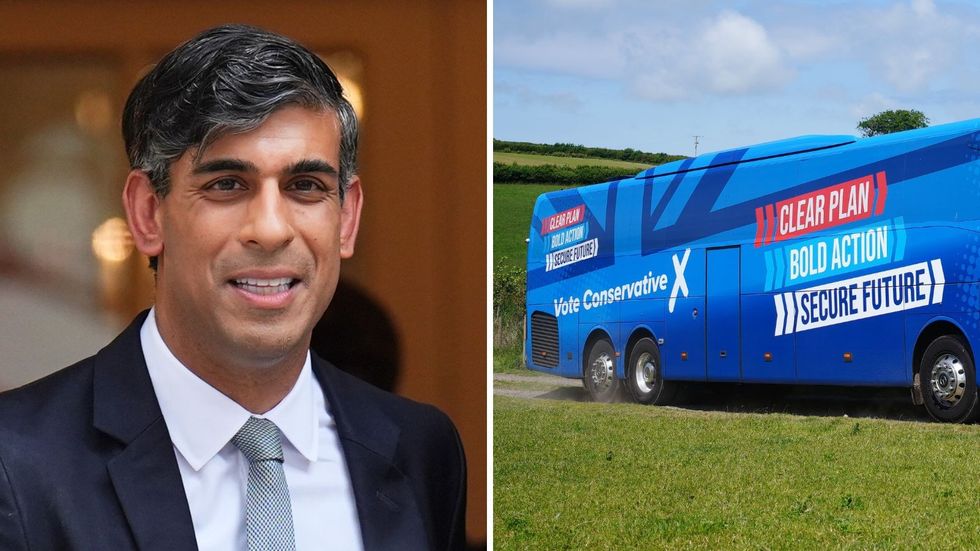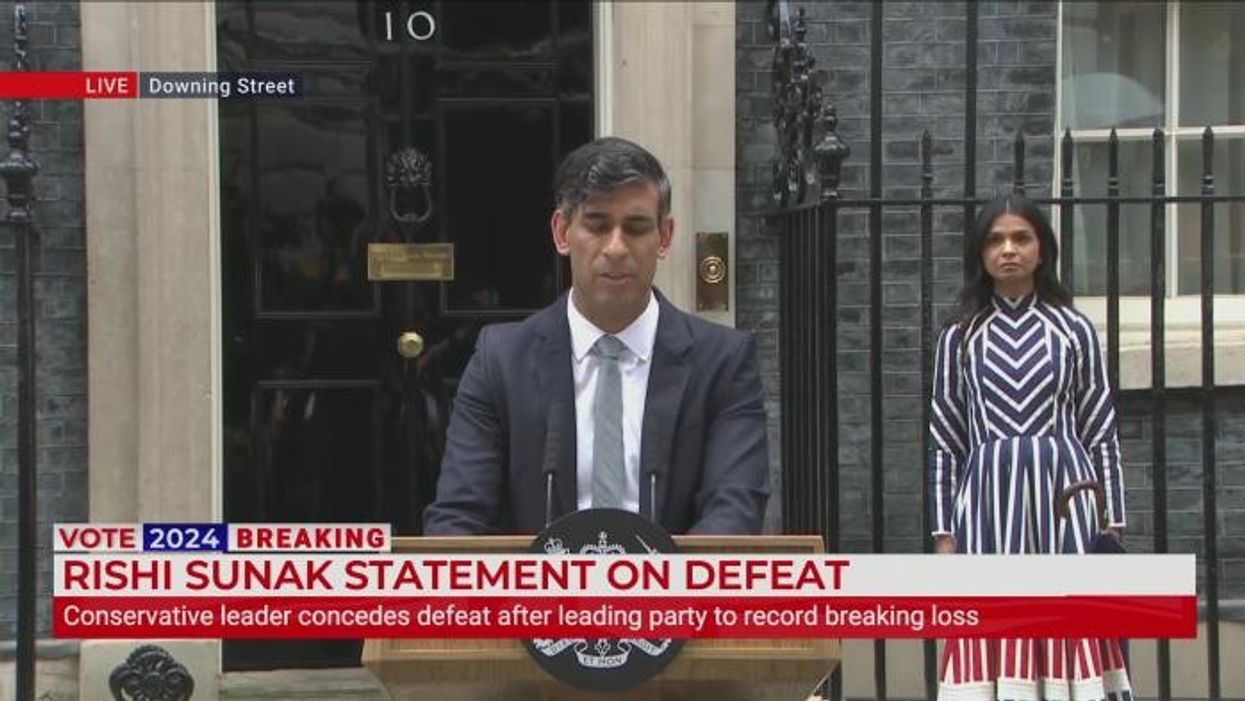15 seismic Tory battleground losses where Conservative Party vote share crumbled

The Tories were reduced to 121 seats as Rishi Sunak led the Conservative Party to its worst result since 1906
Don't Miss
Most Read
After facing electoral threats on all fronts, Rishi Sunak has emphatically lost the 2024 General Election.
The Prime Minister, who conceded defeat to Sir Keir Starmer while at his count in Richmond & Northallerton, leaves the Tories with 250 fewer seats than the number picked up in the 2019 General Election.
A number of Tory bigwigs were culled during the electoral drubbing, including Commons Leader Penny Mordaunt and Defence Secretary Grant Shapps.
The Tory Party will hope to rebuild ahead of the next general election, winning back Reform UK supporters and halting the Liberal Democrats' Blue Wall surge.
Despite only marginally increasing Labour's vote share compared to Jeremy Corbyn's 2019 result, Starmer also managed to make dozens of gains in once-safe Tory seats.
GB News has crunched the numbers to identify the 15 seismic Tory battleground losses which voters might not be aware of.
Tory heartlands crumble: From Dorking to Bury St Edmunds
The Tory Party's traditional heartland seats were among those which collapsed overnight.
Dorking, which has been represented by a Conservative MP since 1885, fell to the Liberal Democrats by more than 5,000 votes.
Tory support collapsed by 20.1 per cent, with the Liberal Democrats surging by 9.8 per cent.
Reform UK appears to have played a major role in the change as the populist party picked up 6,898 votes.
Bury St Edmunds & Stowmarket painted a similar picture but Labour emerged as the beneficiaries.
The Suffolk seat, also Tory held since 1885, returned Labour's Peter Prinsley by just 2.9 per cent.
Tory manifesto architect Will Tanner was put forward as the Conservative candidate.
However, a 32.9 per cent collapse in Conservative support and 16.9 per cent jump for Reform UK spelled immediate trouble.
Brexit fragmentation offers Labour hope in traditional battlegrounds: Amber Valley and Cannock Chase
The 2019 Brexit Election appears to have inflated the perception of strong Tory support.
Amber Valley's Conservative vote share collapsed from 64 per cent to just 25 per cent, with Reform UK supplanting the Tories in second on 29 per cent.
Labour, who last held the seat in 2005, saw their vote share creep up from 27 per cent to 37 per cent.
It joins a plethora of traditional marginals now well and truly up for grabs.
Cannock Chase also represented a drastic switch since 2019.
Reform UK yet again proved the difference, obtaining 27 per cent.
The figure is well above the 17.5 per cent won by Ukip in 2015.
Tory support dropped from 68 per cent to 29 per cent since the last election, with Labour making a nine-point surge to take the party to 36 per cent.
A number of other traditional marginals also fell to Labour, including Harlow and Thurrock in Essex.
Threat from the Greens: North Herefordshire and Waveney Valley
However, a rather surprising set of results came from the Green onslaught against the Tories.
Having only managed to previously clamp down Brighton Pavillion, the Greens snatched North Herefordshire and Waveney Valley.
The result was almost a complete swing, with Tory support dropping by around 30 per cent and the Greens surging by a similar margin.
Green support is growing amid increasing concern about climate change and pro-Palestine sentiment shared by some voters.
The party has made significant progress in both patches at a local level.
However, Labour all fell victim to the Green Party's 4.1 per cent vote increase in Bristol Central.
Blue Wall collapses: Tunbridge Wells, Bicester & Woodstock and Mid Sussex
The Brexit referendum has seemingly shifted the UK's political alignment by how they voted in 2016.
There has been much coverage of a shift in leafy shire seats to the Liberal Democrats.
Mid Sussex, which last elected a non-Tory MP in 1885, saw the Liberal Democrats win by an even greater margin than Reform UK's total vote share added on top of Conservative candidate Kristy Adams.
The shift represented a massive swing as the Tory majority of 18,197 was reversed to put the Liberal Democrats almost 7,000 votes ahead.
Mid Sussex was once seen as such a staunch Tory seat that it was occupied by Winston Churchill's grandson Sir Nicholas Soames from 1997 to 2019.
Tunbridge Wells was also earmarked as a key example of the Liberal Democrats' strength in the Blue Wall.
Army veteran Mike Martin picked up the Kent seat, slashing the Tories' 14,645 vote majority to win by more than 8,000 votes.
However, perhaps Bicester & Woodstock was the most symbolic Liberal Democrat gain.
Calum Miller won by almost 5,000 votes against a candidate with strong links to the Tory Establishment.
The seat also has a rich history with former Prime Minister Winston Churchill.
A Liberal Democrat insider said: "The birthplace of Winston Churchill and home of Blenheim Palace now has a Liberal Democrat MP.
"That really illustrates the scale of the Liberal Democrat triumph here and across Oxfordshire."
READ MORE:

Rishi Sunak stepped down as Conservative Party leader following the general election defeat
|PA
Former Prime Ministers' seats - Thatcher, Cameron, May, Boris, Truss
The Conservative Party has lost all but one of the seats represented by Tory Prime Ministers between 1979 and 2022, including two which elected Boris Johnson.
Margaret Thatcher's former patch of Finchley & Golders Green fell to Labour as Sarah Sackman surged by 19.9 per cent to take her vote share to 44.3 per cent.
Conservative candidate Alex Deane, a regular on GB News, received 35.1 per cent of the vote after taking an 8.7 per cent hit.
The Remain-voting North London seat did flip to Labour during Tony Blair's stint in Downing Street.
However, Thatcher's lowest majority while in No10 sat at 7,878 in 1979.
Lord David Cameron, who has most recently been Foreign Secretary, represented leafy Witney from 2001 to 2016.
Robert Courts lost the seat by 4,341 votes after returning with a 15,177 majority in 2019.
Cameron won the EU-backing Oxfordshire seat by 25,155 votes in 2015, with the Liberal Democrats only obtaining the support of 2,970 of local constituents.
Even Theresa May's seat of Maidenhead crumbled.
The Blue Wall seat, which returned May in 2017 by 26,457 votes, saw the Liberal Democrats win by almost 3,000 ballots.
Both of Boris Johnson's former seats, Henley and Uxbridge & South Ruislip, fell as Liberal Democrats and Labour moved in on the blonde bombshells ex-patches.
Liz Truss even emerged as one of the greatest Conservative casualties, joining Andrew Balfour and Ramsey MacDonald in losing her South West Norfolk seat shortly after leaving No10.
Truss, who remains rather unpopular following her disastrous mini-budget, saw her 26,195 majority reversed as Labour won by 630 votes.
Labour's Terry Jermy amassed 11,847 votes and the party's win in the constituency was undoubtedly helped by 9,958 Reform UK supporters.
Despite a torrid set of results, the Conservative Party's Ben Obese-Jecty won Sir John Major's former seat of Huntingdon - by a narrow 2.9 per cent as the Tories retained its post-war grip on the constituency.
Sunak also retained Richmond & Northallerton by 12,185 votes as Brexit-backing constituents in the Yorkshire seat which last elected a non-Tory MP in 1906 continued to put faith in the former Prime Minister.











